
Portrait taken in bright gardens near KDKA, the television station I left to work in the steel mill. (c. 1981)
Steel Genesis offers metaphors for human mettle and personal genesis from a mill that once nestled on the Monongahela River’s banks. Iron-making operations began before the Civil War. The last steel was poured in April, 1985.
Few experience an old-time steel mill’s awesome, harrowing and magical world. As a young mother, I worked at J&L Steel’s Pittsburgh Works during its heyday when over 10,000 people struggled and snoozed, played pranks and died in that fire and brimstone world. I saw the last steel poured and continued as that acreage was transformed and opportunities rose from the mill’s ashes.
Steel Genesis’ mission is the presentation of human experiences and images of a vanished steel mill. I hope these pages fascinate and inspire because …
When Rear Admiral Ben Moreel, a battleship of a man took charge of the Jones and Laughlin Steel Company in 1947, Pittsburgh Works’ steel mills had no bathrooms. Workers relieved themselves whenever opportunities permitted in the cavernous shadows. The mills also had no locker rooms or showers, so the sweaty and sooty steelworkers smelling of smoke and sulfur rode the trolleys home alongside office employees and shoppers. Others climbed the steep hillsides after their labors ended.
From the South Side Slopes, Greenfield and South Oakland neighborhoods, the households could look down on a mill that cooked ores into iron a decade before the Civil War. Those mills filled the air with ash and smoke that blackened laundry hung out to dry, Pittsburgh’s buildings and the sky. The giant flames shooting from Two Shop’s Bessemer furnaces were so bright that nearby homes never needed lights. Old Birmingham’s webs of tiny streets and alleys were coated with cinders that glittered like diamonds at night.
All Pittsburgh Works needed was the coal and iron ore that came from company mines. Everything else – from nails to the two-story-high ladles – was fabricated and built inside the mill by the steelworkers.
When I walked the land after steel production ended, I sensed the spirits of folks who found jobs for their kids and kin in those shadowy sheds. I suspected the pensive presences of those who worked among the fire and brimstone so family members could go to college. I imagined the rusting beams and crumbling concrete also held the death cries and raucous laughter, the hopes realized and dreams lost of the Pittsburgh Works’ generations.
The buildings are gone, but great memories remain. I do believe they’re in those last scraps of iron, brick and wood scattered along the Monongahela.
Welcome and return often for more Steel Genesis images and stories.
Sandra Gould Ford







